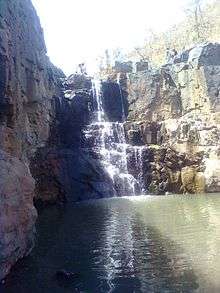Shoolpaneshwar Wildlife Sanctuary
Coordinates: 21°45′38″N 73°47′41″E / 21.7606223°N 73.7948516°E
Shoolpaneshwar Wildlife Sanctuary is located in the districts of Narmada and Nandurbar, respectively in the States of Gujarat and Maharashtra, India.[1][2] This sanctuary has 607.70 km2 area. This sanctuary[1][2] and the Dangs' Forest are located in a region, that is the border-place of the States of Gujarat, Maharashtra and Madhya Pradesh, which is the nearest habitat of the Bengal tiger to that of the Gir lion.[3][4][5] Like the Dangs' Forest, the sanctuary is located across the Gulf of Khambhat from Kathiawar Peninsula, where the lion resides.[1][2][6] Like Ratanmahal and Jessore Sanctuaries, it was designated as a protected area for the Indian sloth bear.[7]
Ecosystem
The physical aspect is dominated by Rajpipla hills. Dhanmal is the highest peak in this region. The general slope is towards west. The sanctuary has a vast undulating terrain, lush ever pervading greenery, tall canopy, deep valleys, sombre rocks, gentle streams, and waterfalls. All of these are in the Vindhyan and Satpuran ranges.
Zarwani Waterfall

The Zarwani Waterfall is deep inside the sanctuary.
Flora
Being within the North Western Ghats moist deciduous forests' ecoregion,[1] the forest is a moist, deciduous one with semi-evergreen elements. It is one of the densest forests in Gujarat. The hilly tract of the sanctuary bordering Narmada River supports forests harboring floral and faunal elements, which bear similarities to those in the Himalayas and Western Ghats. Moist teak forest, moist mixed deciduous forest, dry deciduous scrub, dry bamboo brakes and dry tropical riverine forest are the varied habitats found here. It is also a major watershed feeding two major reservoirs thus conserving the soil and water.[8][9] There are vast groves of bamboo, and the sanctuary has 575 species of flowering plants.
Fauna
This sanctuary is famous for its nocturnal flying squirrels. Many mammals like sloth bear,[7] leopard, rhesus macaque, chousingha, barking deer, pangolin, chital, Indian civet, palm civet, wild dogs, leopard cat and Indian porcupine are found here. Tigers were also found here,[1][2][3][4][5] but have not been seen since two decades, reportedly.
Herpetofauna includes python and many other snakes. Tortoises and many lizards are also present.
Birds, including Alexandrine parakeet, grey jungle fowl, red jungle fowl, crested serpent eagle, shikra, sparrow hawk, great horned owl and grey hornbill are found here.
Access and accommodation
The nearest airport is that of Vadodara, which is about 90.0 km (55.9 mi) away. Sardar Vallabhbhai Patel International Airport at Ahmedabad, which is about 260.0 km (161.6 mi) away, is the nearest international airport. The nearest rail head and bus stand are those of Ankleshwar, which is about 60.0 km (37.3 mi) away. There are rest houses to stay at Bharuch, Dediapada, Rajpipla, and the sanctuary.[1]
See also
- Arid Forest Research Institute
- Bansda National Park
- Jambughoda Wildlife Sanctuary
- Purna Wildlife Sanctuary
External links
References
- 1 2 3 4 5 6 "Narmada District". Onefivenine.com. 2013. Retrieved 2017-01-22.
- 1 2 3 4 "Gujarat Map". mapsofindia.com. Retrieved 2016-03-21.
- 1 2 Karanth, K. U. (2003). "Tiger ecology and conservation in the Indian subcontinent". Journal of the Bombay Natural History Society. 100 (2–3): 169–189. Archived from the original on 2012-03-10.
- 1 2 Jhala, Y. V.; Gopal, R.; Qureshi, Q., eds. (2008), Status of the Tigers, Co-predators, and Prey in India (PDF), TR 08/001, National Tiger Conservation Authority, Govt. of India, New Delhi; Wildlife Institute of India, Dehradun, archived from the original (PDF) on 2 June 2013
- 1 2 Jhala, Y. V., Qureshi, Q., Sinha, P. R. (Eds.) (2011). Status of tigers, co-predators and prey in India, 2010. National Tiger Conservation Authority, Govt. of India, New Delhi, and Wildlife Institute of India, Dehradun. TR 2011/003 pp-302
- ↑ Nowell, Kristin; Jackson, Peter (1996). Wild Cats: Status Survey and Conservation Action Plan (PDF). Gland, Switzerland: IUCN/SSC Cat Specialist Group. pp. 1–334. ISBN 2-8317-0045-0.
- 1 2 Garshelis, David L.; Joshi, Anup R.; Smith, James L. D. & Rice, Clifford G. "Sloth Bear Conservation Action Plan" (PDF). Archived from the original (PDF) on 23 July 2011. Retrieved 18 April 2011.
- ↑ http://www.Gujaratyourisk.com/destination/details/5/184
- ↑ "Shoolpaneshwar Wild Life Sanctuary". Wildlifetrips.in. Retrieved 2015-12-23.
| Wikimedia Commons has media related to Shoolpaneshwar Wildlife Sanctuary. |